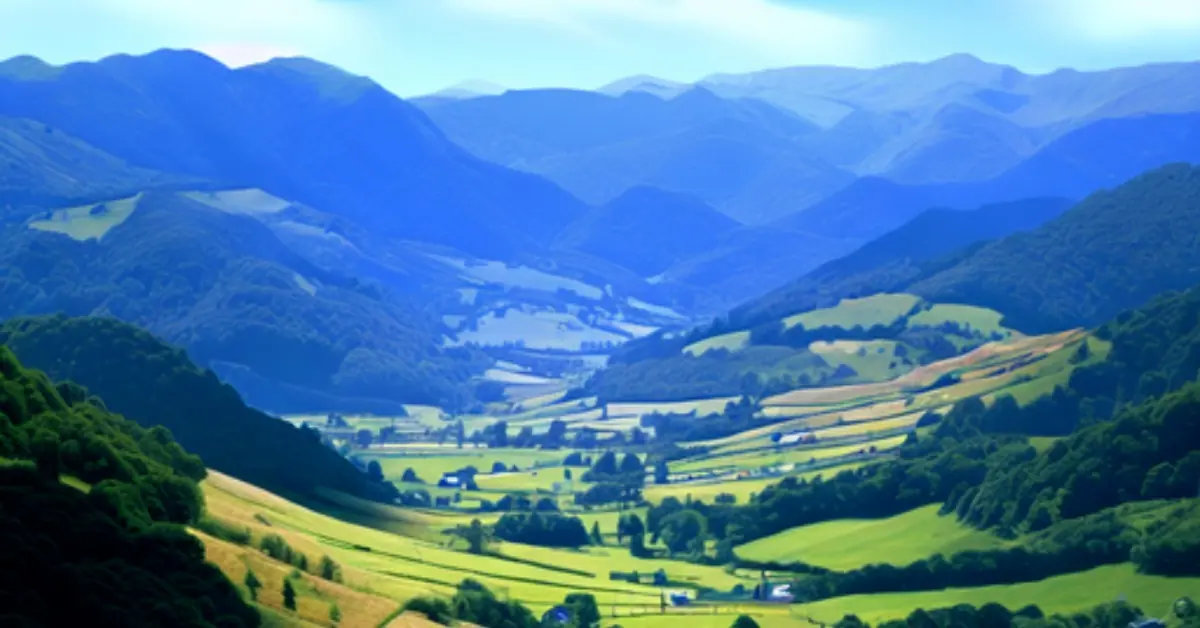
Camino Francés: St. Jean-pied-de-port to Roncesvalles
Posted: | Updated:Reading time: 12 minutes
Camino Francés: St. Jean-pied-de-port to Roncesvalles
Posted: | Updated:Reading time: 12 minutes
By: Simon Kemp, Editor
Map of St. Jean-pied-de-port to Roncesvalles
Camino Francés Diary: Route segment 1
Wednesday 27th September 2000
This proves to be a baptism of fire. I have heard that you follow the yellow arrows. There are very few arrows out of St-Jean-Pied-De-Port and at one particular fork in the road; it is not obvious which way to take. Of course I go right and take the wrong way and get lost for the best part of a day.
The scenery however is fantastic. But the training I did for a few weeks before coming here was not enough and I am struggling up and down steep hills on the worst roads imaginable. Think of the very worst farm track and it is ten times worse. I would not try and drive my 4*4 down those roads. Of course I have lost the proper path but the Camino path itself will prove to be very bad in parts.
It is apparently an old roman road where the nice stonework has deteriorated over the last two thousand years and is now just loose stones and mud and gravel. There are also modernized parts later in Spain, which are concrete or tarmac or have been improved for the benefit of local industry, such as the sections through parts of La Rioja.
It is still relatively early in the morning and it is quite misty. But the views as I walk are good:-
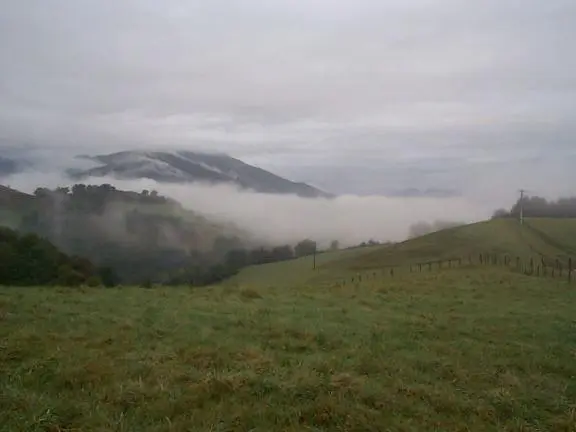
I find that it will take at least 3 days to get used to the backpack and my shoes. I will have problems with friction between the topmost parts of my inner thighs, which will need medical attention later. The worst problem will be a swelling of the muscles at the bottom of the front of my left leg, which will result in me stopping for several days later, in Burgos to recover.
Everyone will have an injury of some sort and it will become a common sight every evening to see my friends moving around very slowly after reaching a refuge and taking off their footwear.
I eventually reach a road and this proves to be the same road, which I traveled on the previous day from Pamplona. I walk on the road until I get to Arneguy. I have heard that Spanish coffee is good and want to try a cup in a bar. But the bar here is not open this time of the day and the barman points me to the next village, Valcarlos.
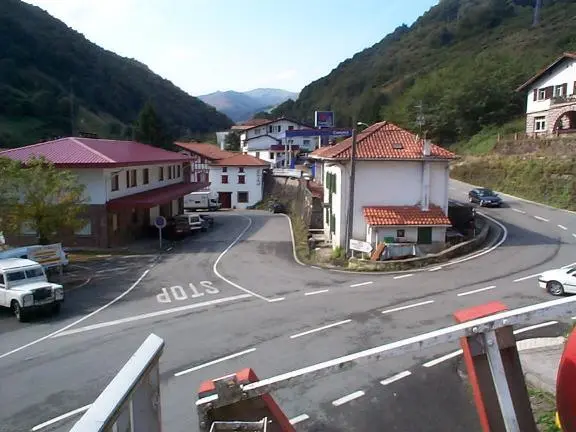
I eventually reach Valcarlos where I have the first coffee of the Camino. It is the best coffee I have ever tasted and I begin to look forward each day to the first Grande cafe con leche of the day. They always use freshly ground coffee and use a fancy machine to make it.
It looks to me that they use an enormous amount of coffee for each cup and it is certainly strong stuff. On the road again, it seems that the path takes the road for most of the way now. The road is easy to walk on and at least 30 or 40 caravans must have been passed by on their way to Spain.
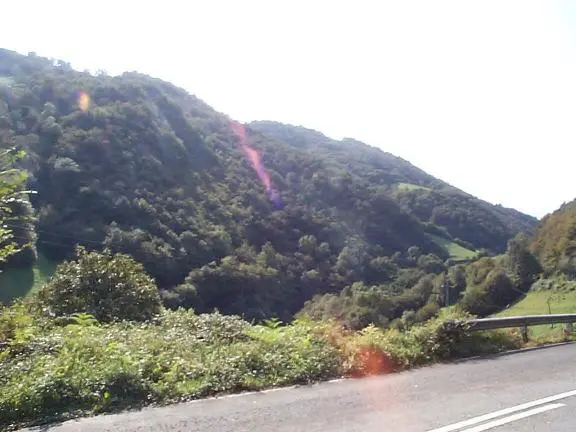
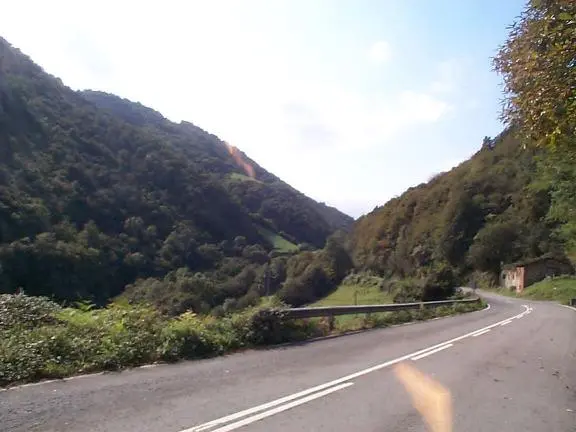
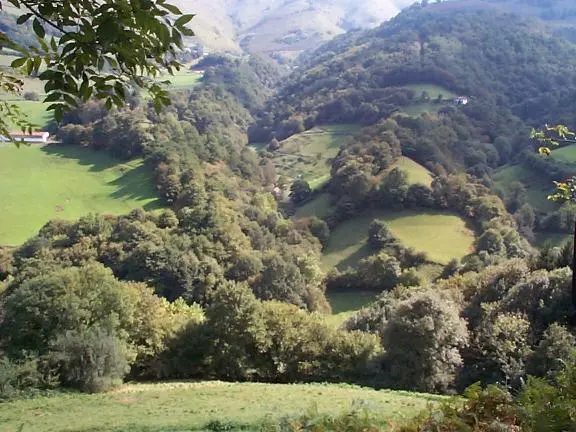
I find a sign, which directs me onto the Camino path. This goes onto rapidly rising tracks and I get a first taste of the typical Camino path. The path leads through forest and the views are fantastic. As it is my first day I do not know how to pace myself and it is getting into late afternoon and I have not reached the Ibaneta Pass which is the topmost part of the route through the Pyrenees. I am starting to worry that I will have to spend the night in the forest without a tent.
Eventually I reach the pass and am glad as it means only another 4 KM to go to get to Roncevalles. The pass is above 2500 meters and the air does seem thinner that normal.
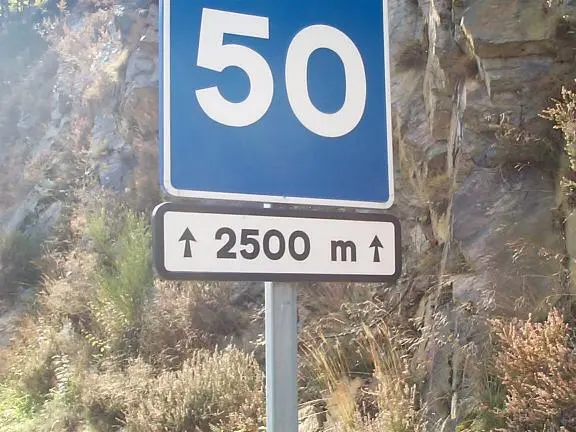
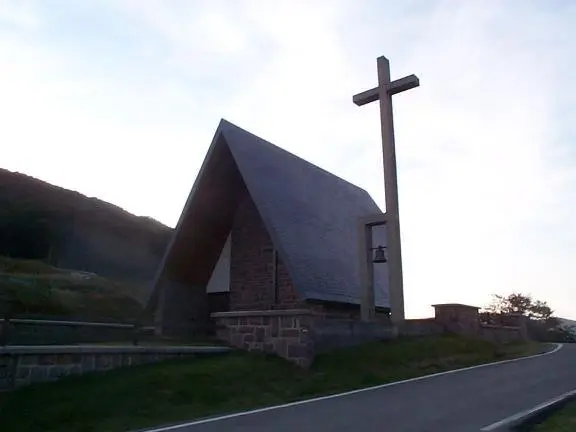
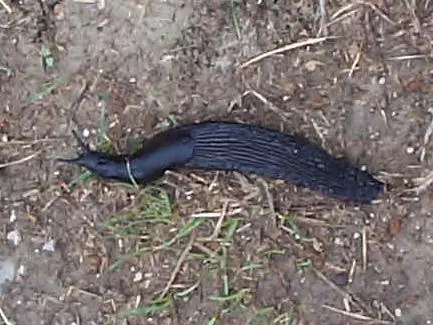
The path starts to wind down from here. I hear the sounds of cowbells but it is coming from the road and as I turn the corner, I am presented with the sight of a large herd of mountain goats. They are blocking the road and won’t move out of the way of the cars on either side. This goes on for at least half an hour and I don’t feel like trying to pass them either as I have heard that goats can be aggressive creatures.
As it happens I pass them later with no problems at all. I have also heard that pilgrims have problems with dogs on the Camino but I will find that again I have no problems with the unchained ones. It is the chained ones that make all the noise and no wonder, I would too if I was kept in such circumstances.
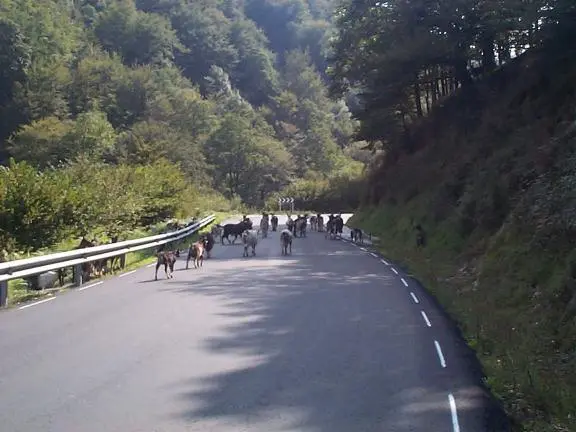
When I eventually reach Roncesvalles, it is only a few minutes to closing time for the office. I get the passport stamped and arrange for the room for the night. But this is a monastery and there are strict rules in Spanish that I cannot read and the asshole of a priest starts shouting at me in Spanish. Eventually he grabs me by the arm and pushes me and my backpack out of the refuge. I am in shock and start to wonder how I am going to spend the night.
This will not be the worst treatment that that particular priest will hand out to a pilgrim and I will speak to one Brazilian girl later who was turned out with all her stuff still in the room. She could not get it back until the morning so my experience was not the worst or uncommon. But it was a bad way to start the pilgrimage for me. It turns out that there was a mass and he wanted the room empty and locked during it.
I meet the Dutch guys in the bar nearby and they explain it all to me. I do manage to get back in later and I am kept awake all night by the most incredible variety of snoring I have ever heard. I begin to find it rather amusing and I was probably just too exhausted for sleep. I tried reading a book for a while, but it was too noisy. This time there were about 40 people in the room including a Spanish brother and sister, Daniel and Olivia and another Spanish chap, Geordie. I will keep meeting them again and again until Logroño where they stop and go home to start university.
Many of the people on the Camino are students and they don’t have the time to do the full trip before starting studies. Some are retired and have plenty of time and some are professionals like myself who only have enough time to do part of the trip but may already have done another part before or will do another part later.
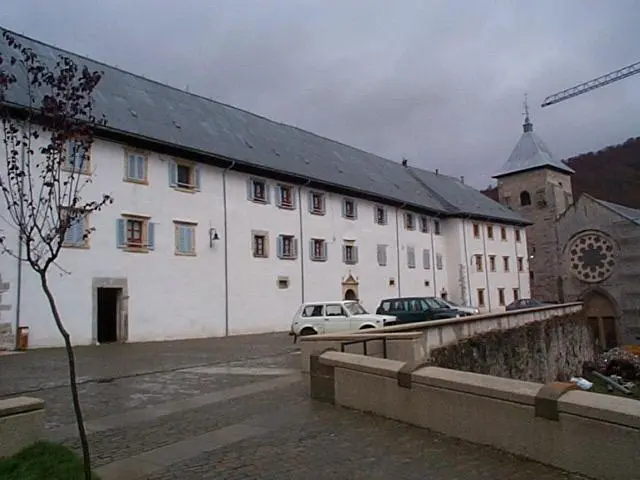
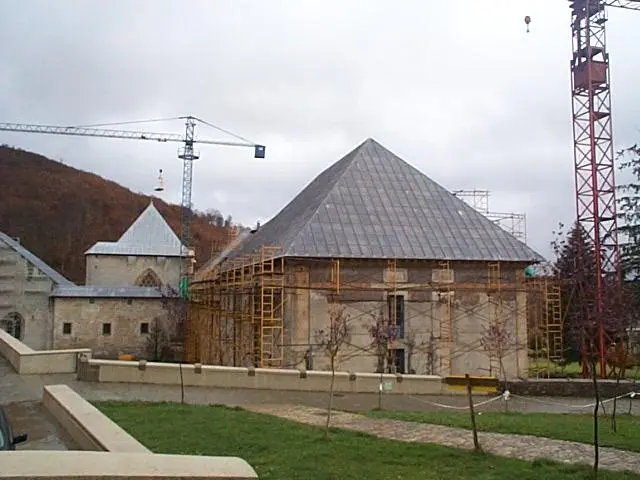
On my second Camino, I attempted to walk the traditional route and this is what awaited me:-
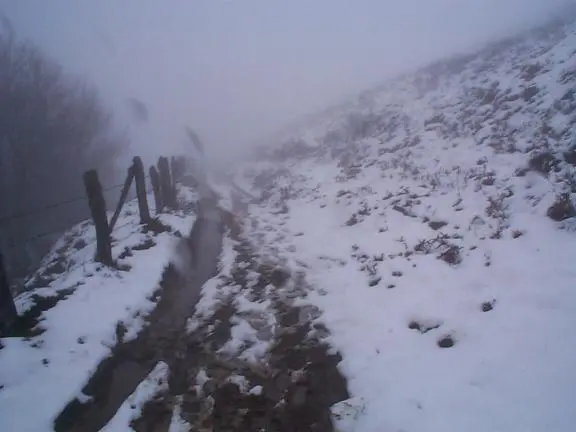
Departure point: St Jean-Pied-de-Port
Saint-Jean-Pied-de-Port, situated in southwestern Francés, is a small but enchanting town that holds great significance as the starting point for the Camino Francés pilgrimage to Santiago de Compostela. This town boasts a rich history and offers various services and attractions for visitors, making it a popular destination.
Location and History
Located at the foot of the Pyrenees, Saint-Jean-Pied-de-Port is an ideal spot for hikers and outdoor enthusiasts who appreciate the breathtaking scenery that surrounds it. Since the Middle Ages, it has been an important stop for pilgrims heading towards Santiago de Compostela. Moreover, the town’s strategic location played a vital role in several military conflicts, including the Hundred Years’ War and the Peninsular War.
Points of Interest
Visitors to Saint-Jean-Pied-de-Port will find a wide range of attractions to enjoy, with the UNESCO World Heritage Site, Porte St-Jacques, being one of the most notable ones. It is the traditional starting point for the Camino Francés pilgrimage and a remarkable gate built in the 12th century that has been welcoming visitors for centuries. The town also features a 17th-century citadel that was constructed to defend against attacks. The Gothic Church of Notre-Dame du Bout du Pont is yet another famous landmark, dating back to the 13th century. A 14th-century Gothic bridge across the Nive River is an ideal place to stroll and relish the picturesque views. The historic center of Saint-Jean-Pied-de-Port is worth exploring with its quaint alleyways, half-timbered houses, and traditional Basque architecture.
Camino-related Services
As the starting point for the Camino Francés, Saint-Jean-Pied-de-Port offers various services for pilgrims. These include hostels and hotels, specifically catering to pilgrims’ needs. Visitors can also enjoy traditional Basque cuisine served in restaurants and cafes. Essential services such as pharmacies and medical facilities are also available to pilgrims, making the town an excellent and practical place to embark on the Camino Francés pilgrimage.
Saint-Jean-Pied-de-Port is an enchanting and historically rich town, offering a range of services and attractions to visitors. Whether you are embarking on the Camino Francés pilgrimage or exploring the region as a tourist, this charming town is a destination worth visiting.
Route Description: St-Jean-Pied-De-Port to Roncesvalles
The first stage of the Camino Francés, from St-Jean-Pied-De-Port to Roncesvalles, is considered one of the most challenging stages due to the steep ascent through the Pyrenees Mountains. However, the stunning views and sense of accomplishment make it worth the effort. Here is a detailed route description for this stage. It’s recommended to spend the night here to rest and prepare for the challenging trek ahead.
Route Description
The route begins at the Pilgrim’s Office in St-Jean-Pied-De-Port and climbs uphill through the town’s narrow streets. After crossing the Nive River, the route continues through the countryside, with stunning views of the mountains and valleys.
Col de Lepoeder
After about 6 kilometers, the route reaches the Col de Lepoeder, the first significant ascent of the stage. The climb is steep and challenging, but the stunning views make it worth the effort.
Col de Bentarte
The route continues uphill to the Col de Bentarte, which offers breathtaking views of the Pyrenees Mountains. This section of the route is considered one of the most beautiful parts of the Camino Francés.
Roncesvalles
After the Col de Bentarte, the route descends towards the Spanish border and eventually reaches the town of Roncesvalles, located in a picturesque valley. The town has a historic monastery, where pilgrims can stay and attend a pilgrim’s mass.
Tips and Recommendations
- It’s recommended to start early in the morning to avoid hiking in the heat of the day.
- Make sure to bring plenty of water and snacks, as there are few options for food and water along the way.
- Wear comfortable and sturdy hiking shoes with good ankle support.
- Be prepared for changing weather conditions and bring appropriate gear, including rain gear and warm clothing.
- Consider hiring a baggage transport service to carry your backpack, as the steep ascent can be challenging with a heavy load.
The first stage of the Camino Francés from St-Jean-Pied-De-Port to Roncesvalles is a challenging but rewarding journey through the beautiful Pyrenees Mountains. With stunning views, charming towns, and historic landmarks along the way, it’s an unforgettable experience for any pilgrim.
Destination: Roncesvalles
Roncesvalles is a small village in the Pyrenees mountains of northern Spain that is located on the Camino Francés pilgrimage route to Santiago de Compostela. The village has a long and fascinating history, and it offers a range of attractions and services for visitors.
Roncesvalles is a beautiful and historically rich village that serves as an important stop on the Camino Francés route . Its location in the Pyrenees, range of attractions, and variety of services make it a popular destination for visitors. Whether you are a pilgrim embarking on the Camino or a tourist exploring the region, Roncesvalles is a village worth visiting. The combination of stunning natural scenery, historical significance, and cultural attractions make it a unique and memorable destination.
Location and History
Roncesvalles is located in the Navarre region of northern Spain, close to the border with France. The village sits at the foot of the Pyrenees mountains and is surrounded by beautiful landscapes, making it a popular destination for hikers and outdoor enthusiasts. Roncesvalles has a long and important history, dating back to the Middle Ages when it was an important stop on the Camino de Santiago pilgrimage route. The village was also the site of a famous battle in 778 AD between Charlemagne’s army and a Basque force.
Points of Interest
Roncesvalles offers a range of attractions for visitors. One of the most notable is the Collegiate Church of Roncesvalles, a beautiful Gothic-style church that dates back to the 12th century. The church is home to a museum that contains many artifacts related to the history of the village and the Camino de Santiago pilgrimage. Visitors can also explore the village’s historic center, which is characterized by narrow streets, traditional Basque architecture, and beautiful views of the surrounding landscapes. The village also offers a range of hiking trails and outdoor activities, including the popular Camino de Santiago pilgrimage route.
Camino-related Services
As a stop on the Camino Francés pilgrimage route, Roncesvalles offers a range of services and amenities for pilgrims. Accommodation options include hostels and hotels, with many specifically catering to pilgrims. Visitors can also find restaurants and cafes serving traditional Basque cuisine, such as pintxos (small snacks typically eaten with drinks) and stews. Shops selling souvenirs and other essentials are also available. Medical facilities, pharmacies, and other essential services are also available for pilgrims, making it a convenient and practical destination.